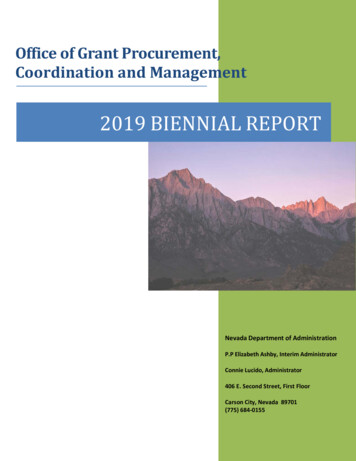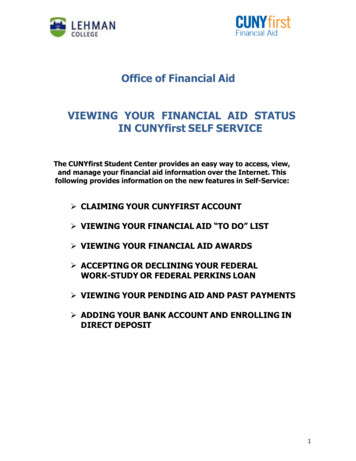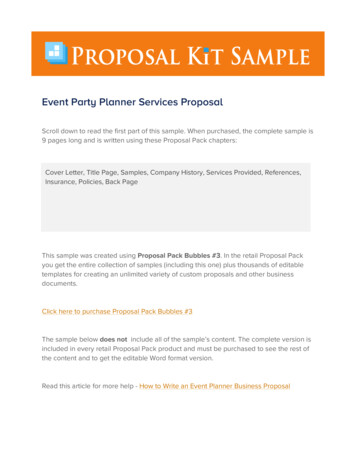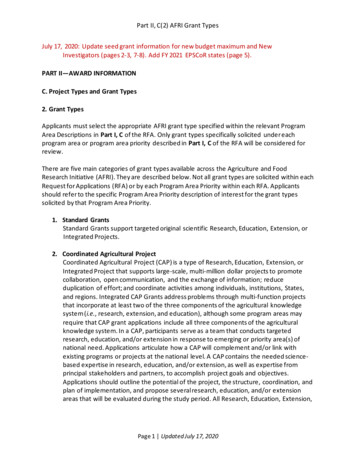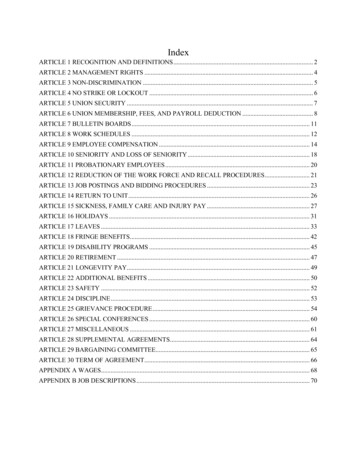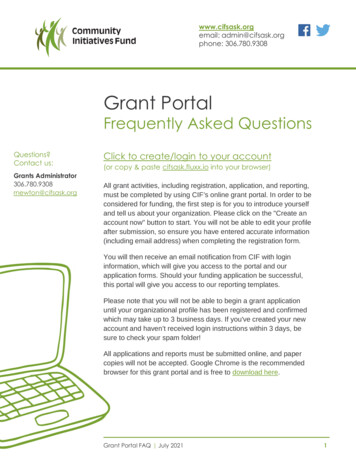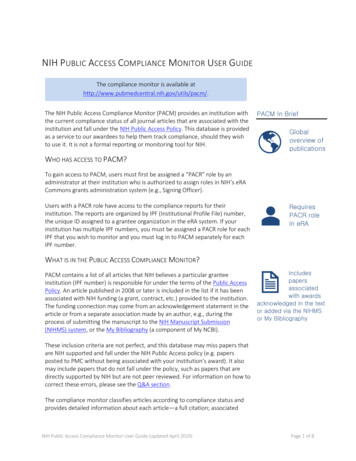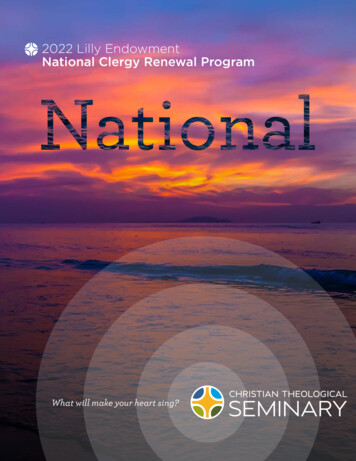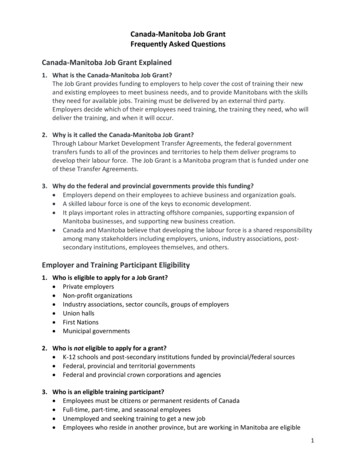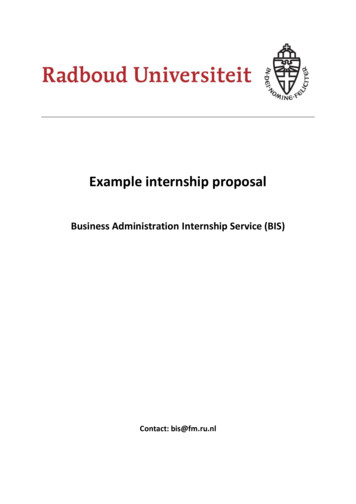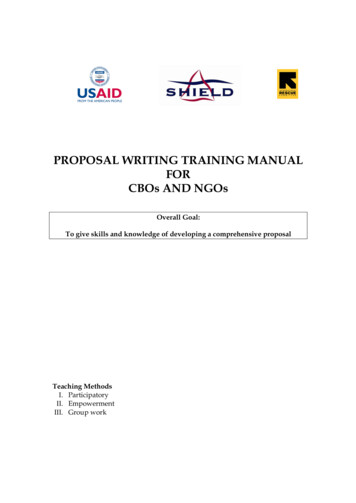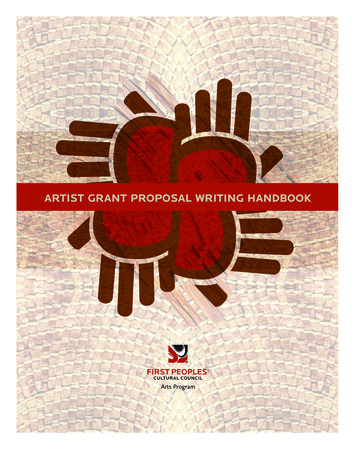
Transcription
130412 - -Apr-1211:18 AMARTIST GRANT PROPOSAL WRITING HANDBOOK
TABLE OF CONTENTSINTRODUCTIONPage 3WHAT IS ARTS FUNDING?Page 4SELECTING AN ARTS FUNDING PROGRAMPage 5 FINDING THE BEST FIT FOR YOUR PROJECT Artistic Discipline Nature of Your Project Idea Your Level of Experience HOW THE PROGRAM OFFICER CAN HELP APPLYING TO MULTIPLE SOURCES FOR FUNDINGBEFORE YOU BEGIN WRITINGPage 7 PREPARING Get Familiar with Program Descriptions and Guidelines Timing is of the Essence CHECK APPLICATION DEADLINES LEAVE YOURSELF ENOUGH TIMEWRITING YOUR PROPOSAL GETTING STARTED Beginning to “Put Pen to Paper” Clarifying Your Project Idea RESPONDING TO QUESTIONS ON AN APPLICATION FORM Your History and/or Philosophy as an Artist Writing a Description of Your Project Including a Project Timeline Developing a Clear Budget Writing About Potential Outcomes and Benefits of the Project Organizing Samples of Your Artwork The List of Works The Application ChecklistPage 8
FINAL TIPS: WHAT NOT TO DO IN A GRANT PROPOSAL EDITING YOUR PROPOSALHOW AN APPLICATION IS ASSESSED WHEN WILL YOU HEAR NEWS? WHO WILL BE MAKING THE DECISIONONCE THE DECISION IS MADE YOU GOT THE GRANT: WHAT NOW? Celebrate Your Success and Start Realizing Your Vision! What if you need to change part of your project? Making Yourself Eligible for Future Funding YOU DIDN’T GET THE GRANT: WHAT NOW? Rejection is a Hard Part of Being an Artist Seek Constructive Feedback and Try AgainFINAL THOUGHTSPage 14Page 15Page 17Original document created with the generous support of:Artist Grant Proposal Writing Handbook – First Peoples’ Cultural Council2
INTRODUCTIONWelcome to the Artist Grant Proposal Writing Handbook developed by the FirstPeoples’ Cultural Council (FPCC), Arts Program.For many of us, writing a grant application or proposal can seem overwhelming. Simplyfiguring out which funding program to apply to can be confusing and explaining our ideasclearly on an application form isn’t always easy.The purpose of this handbook is to offer suggestions and clarify the process of writing an artsgrant proposal. This handbook will explain the nature of arts funding and identify whichorganizations to apply to. You will be introduced to the common contents of an arts grantapplication form and provided with advice on how to create a clear and strong proposal foryour project.Please let us know if you have any suggestions on other resources that would be helpful toartists and arts administrators.Here’s how you can reach us:First Peoples’ Cultural Council1A Boat Ramp Road Brentwood Bay, BC V8M 1N9Phone 250-652-5952 Fax 250-652-5953Website www.fpcc.ca General Email info@fpcc.caArts Program Outreach and SupportAboriginal Art Development Awards ProgramsArts Program AssociateContact Steven Davies at steven@fpcc.caArts Program ManagerContact Cathi Charles Wherry at cathi@fpcc.caArtist Grant Proposal Writing Handbook – First Peoples’ Cultural Council3
WHAT IS ARTS FUNDING?Arts funding helps to sustain the practice of the arts across the country and beyond. If youare an individual artist, grants are an important resource to help you maintain your artisticpractice. If you are a representative of an arts organization, grants can be a source of fundingto help you continue to support the arts in your community.Grants for artists, arts organizations and arts collectives in British Columbia are distributedthrough a variety of arts funding organizations including: First Peoples’ Cultural Council (Aboriginal artists and organizations in BC only)British Columbia Arts Council (BC artists only)Vancouver Foundation, Visual Arts Development Awards (BC visual artists only)Canada Council for the Arts (Artists across Canada)Arts Funding for Individual ArtistsThere are several grant opportunities available to individual artists related to projects such as: The creation and/or production of new works Professional development opportunities Artist in residency opportunities Travel relevant to your art practiceArts Funding for OrganizationsMany grant programs are designed to support arts organizations. First Nations/BandAdministrative offices and Native Friendship Centres are also eligible to apply to some artsfunding programs, provided that they can demonstrate a clearly articulated arts mandate.Funding for arts organizations can include support in the form of: Organizational operating funds Organizational development assistance Project assistance Presentation and dissemination assistanceArts funding organizations offer many grant programs to support the work done by artists andarts organizations. Since there are so many funding possibilities, it is important to be surethat you are applying to the arts program that best suits your project and your needs.It is important to note that arts funding programs do not fund business ventures. If you thinkthat your idea may qualify as a business concept, rather than an arts project, there arebusiness specific resources that may be a more appropriate source of support.Artist Grant Proposal Writing Handbook – First Peoples’ Cultural Council4
SELECTING AN ARTS FUNDING PROGRAMFINDING THE BEST FIT FOR YOUR PROJECTThere are several factors to keep in mind as you select the arts funding program to which youwill apply. Specifically, your choice of grant program will be influenced by your artisticdiscipline(s), the nature of the project you wish to undertake and your level of experience.Artistic DisciplineArts funding opportunities are often categorized related to seven main artistic disciplines.Generally, these disciplines are defined as follows:1.2.3.4.5.6.7.Visual artsDanceMusic/soundTheatre/performing artsWriting/storytellingMedia artsInterdisciplinary artsIn order to avoid disappointment, it is important to make sure that the grant program youapply to is geared towards your specific artistic discipline. You should review the grantprograms’ description and guidelines for to find information about which artistic disciplinesqualify for a funding opportunity.Nature of Project IdeaYou will find that most arts organizations offer a variety of grants that are dependant on thenature of your project idea. For example, within each artistic discipline, you are likely to findspecific funding for projects related to: Travel,The creation of new works,Art production,New audience development,Touring,Capacity building, and others.You can find information about the nature of the projects supported by a grant outlined in thegrant program’s description and guidelines. If you are still unsure if your idea fits the criteria,you can contact the grant program’s Program Officer to discuss your ideas (for moreinformation, see How the Program Officer Can Help section of this handbook).Artist Grant Proposal Writing Handbook – First Peoples’ Cultural Council5
Level of ExperienceIt is also important to select a funding program that fits you or your organization’s level ofexperience in the arts.Career Level as an Individual ArtistYour career level as an artist is determined by the training and apprenticeships you haveundertaken, the length of time you have been practicing and whether or not you haveproduced a significant “body of artwork.” Also considered is your history of publicpresentations (i.e. exhibitions or performances of your work) and the level of recognition youhave received from your peers and community. Individual artists often fall into the followingcategories of experience: Emerging Artist (new/learner to approximately 3 or more years) Practicing/Establishing Artist (approximately 3 years to 5 or more years) Professional/Senior Artist (approximately 5 years to 10 or more years) Mentor/Master Artist (approximately 10 years or more years)Level of Establishment as an Arts OrganizationThe level of experience of an arts organization is evaluated based on a variety of criteria,including how long an arts organization/group has been in existence, as well as the level ofexperience of the artists/arts administrators involved. Other factors include an organization orgroup’s historical and ongoing activities related to the arts, their history of receiving artsfunding and their successfully completion of past projects.Once you have explored various funding sources and have determined the program(s) youqualify for based on the above criteria, it can be helpful to contact the Program Officer(s) incharge of your grant program(s) of interest in order to confirm the suitability of your choice.HOW THE PROGRAM OFFICER CAN HELPProgram Officers are employed by funding organizations to oversee the administration of artsfunding programs. They do not usually have the authority to decide who receives a grant,though it is their job is to determine your eligibility to apply and to oversee the peerassessment process (discussed later in the handbook). Program Officers are helpful resourcepeople for potential applicants, as they can provide some guidance regarding how yourproject fits within a given funding program and provide tips to strengthen your application.The name and contact information for the Program Officer can usually be found in theprogram guidelines of a grant program. Contacting the Program Officer well ahead of thegrant deadline will ensure they have time to respond to your inquiries effectively.APPLYING TO MULTIPLE SOURCES FOR FUNDINGIf your proposed project involves several stages and/or is a large-scale production, you mayconsider applying to more than one funding source. Specifically, for large-scale projects, it isnot unusual for applicants to secure some of their funding through one grant program andthen use this first amount of funding to “leverage” more financial support from a second orthird funding agency.Artist Grant Proposal Writing Handbook – First Peoples’ Cultural Council6
BEFORE YOU BEGIN WRITINGPREPARINGNow that you have decided on the right grant program for your project, there are severalimportant steps before you begin writing. These steps include familiarizing yourself with theprogram’s description and guidelines, and creating a plan to get your proposal in on time.Get Familiar with Program Descriptions and GuidelinesBefore you start writing, you will want to spend some quality time studying the programdescription and guidelines specific to the grant program you are applying to. Though this maynot sound like the most exciting way to spend your time, it is the best way to avoid wastingyour resources and emotional energy on a grant program that does not fit your project idea.Within a grant program’s program guidelines, you will find the program description. Theprogram description outlines the types of projects considered eligible for funding, as well asthe types of projects that are considered ineligible for this specific funding opportunity. In thissection, you will also find information regarding the funding organization’s priorities andvision. This can be helpful information when writing about the how the outcomes of yourproposed project are in line with the goals of the funding organization.Timing is of the EssenceStress can kill the excitement and creative process that lies at the heart of planning asuccessful project. As a result, it is important to look ahead as much as possible and makesure that you are not going to be surprised or pressured by the unexpected.Check Application DeadlinesOne of the first things to do when considering applying to a grant program is to find out thedue date when you will need to have your application submitted. Each funding opportunityhas its own unique submission deadline(s). Many grant programs have one annual deadline,while others have several deadlines per year or accept applications on an on-going basis.You will also want to clarify ahead of time whether your completed application needs to bereceived (at the funding agency) on or before the deadline or if your application will beaccepted if it is postmarked (at the post office) on or before the deadline.Leave Yourself Enough TimeOnce you know the deadline for the submission of your application, you can plan the stepsyou will need to take in order to complete your application on time. Grant writing takes timeand it is best to start work on your application as soon as you know you will be applying. Infact, it can often take between one to two months to organize your ideas, write your proposal,seek out letters of support, create high-quality samples of your work and make your finaledits. You may find it helpful to create your own “grant-writing calendar” that includes thedeadlines you have set for yourself to complete various stages of your proposal.Artist Grant Proposal Writing Handbook – First Peoples’ Cultural Council7
WRITING YOUR PROPOSALGETTING STARTEDWhen first sitting down to begin writing a grant application, it is not unusual to feeloverwhelmed by the process of putting your ideas into words. The important thing is to simplygetting something down on paper (or on your computer), remembering that you can alwaysmake changes at a later time if you are not happy with what you have written.Beginning to “Put Pen to Paper”You may already have a well-developed idea of your project in your head, but you will likelyneed time to translate your vision into words on a page. Beginning to write requires that youallow yourself to get your ideas out, without the pressure of having your thoughts come outperfectly on the first go. It is often useful to allow your mind to wander freely and write downall the thoughts that come to you, without judging your ideas or your writing.Since you likely think about your project idea at various points in your day, you may also findit useful to carry around a little notebook to record ideas as they come to you. You can thenbe sure that your moments of inspiration will not be forgotten, as your notebook will be withyou when you sit down to complete the grant application form.Clarifying Your Project IdeaWhen clarifying your project idea, it is helpful to breakdown the elements involved in yourproject. In order to help you with this process, we have provided the following questions towill help you create a clearer picture of your project idea. You will also find space to writeyour responses to these questions on the next page of this handbook.1. What artistic medium is the main focus of my project?2. What is my level of experience working in this artistic medium?3. What would I like to have completed at the end of this project?4. What is the main focus of this project?5. Does my project idea fit into any categories such as; the exchange ofknowledge, the production of new work, the development of new skills, theexhibition or production of previously completed work, etc.?6. Is travel a central cost in this project?7. Does my project involve other artists such as a mentor, collaborator, etc.?8. What makes this project important to me, my community and/or my culture?Artist Grant Proposal Writing Handbook – First Peoples’ Cultural Council8
NOTES:Artist Grant Proposal Writing Handbook – First Peoples’ Cultural Council9
RESPONDING TO QUESTIONS ON AN APPLICATION FORMQuestions asked on grant application forms vary between funding organizations, as well asbetween funding opportunities within each organization. As a result, no matter how manygrant applications you have written in the past, it is always important to respond directly to thespecific questions found on every application form you complete.There are a few key types of questions that can be found in most applications for artsfunding. These can include, but are not limited to questions about: Your history and philosophy as an artist,The proposed project (including a time line and budget), andThe expected outcome(s) and benefits of the project.When formulating your responses to questions, it can be helpful begin your response by firstparaphrasing the question on the application form. For example, if an application form asks:“What are the community benefits of this project?” You can begin your response as follows:“The community benefits of this project are ” This paraphrasing approach can help you startwriting and can ensure that you are responding directly to the questions asked. (For detailedexamples of answers to common questions on art grant application forms, please iting-handbook/sample-questions-and-responsesor contact our office to request hard copies).Your History and/or Philosophy as an ArtistOn application forms for arts funding, there are almost always questions in that seekinformation about you as an artist or as an arts organization. For individual artists, thesequestions often ask about your background, art practice, any training you have received inthe arts, information about your creative process as an artist (the steps you go through tocreate your work) and a few highlights of your successes. For arts organizations, thesequestions often ask about your organization’s philosophies and values, the expertise of artistsor arts administrators involved and highlights of past projects.If you have already written documents for your artist’s or arts organization’s portfolio (formore information, please see the Arts Portfolio Handbook), you can pull information from yourportfolio (biography and statement) when writing your responses to these types of questions.At the same time, it is very important to adapt your artist’s bio and statement to relate themdirectly to the requirements of each grant program.Many grant programs will also offer you the opportunity to attach your artist's bio, artist’sstatement, and arts resume/CV (or the equivalent for an organization). If you do include thesedocuments, be sure that they are in addition to answering the questions on the applicationform and do not simply write, “see attached,” in the space provided.Artist Grant Proposal Writing Handbook – First Peoples’ Cultural Council10
Writing a Description of Your ProjectNow that you have take some time to ask yourself questions about your project and haveallowed yourself some freedom to dream, you are probably ready to streamline your projectidea into a project description. Some grant application forms will ask specific questions aboutthe nature of your project, while other applications will ask you to include a concise “projectdescription.” At this point, it is good to make sure that you have the ‘who, what, where, when,how and why’ of your project clarified. Specifically: Who will be involved in the project?What form will the project take? What will be involved?Where will the project take place?When will the project take place?How will the project proceed?Why are you doing this project and why is it important?In addition to the questions listed above, art funding opportunities that are specificallydesigned for Indigenous art practitioners may require that you explain how you will addressthe necessary cultural protocols in the planning and execution of your proposed project.Including a Project TimelineAs part of your project description, many funding agencies will ask you to provide a timelinethat indicates how your proposed project will proceed. This timeline allows the assessmentcommittee to understand the progression of your project and demonstrates that you havethought through the steps necessary for its successful completion.When constructing your timeline, you will want to imagine how long it will take you to carryout your project. You will then create a simple chart that breaks down your project plan byeither weeks or months, depending on the length of your proposed project. It is best to keepyour timeline simple and concise, yet complete. (For a detailed example of a project timeline,please visit ng-handbook/sample-workplantemplate or contact our office to request a hard copy.)Developing a Clear BudgetYour budget plays a critical role in your application for funding and will often make or breakthe success of a proposal for art funding. Most grant application forms will provide you with abudget template where you outline all the costs (project expenses) involved in your project,as well as the source of the funds you will use to pay for your project (project revenues). If abudget template is provided in the application form, we highly recommend that you use theformat provided by the funding organization. If there is no budget template provided in theapplication form, you will need to choose one that is clear and easy to understand. (For adetailed example of a budget, please visit nghandbook/sample-budget-template or contact our office to request a hard copy.)Artist Grant Proposal Writing Handbook – First Peoples’ Cultural Council11
Elements that are critical to address in your project budget include: A breakdown of how much the proposed project cost (Project Expenses)Any additional sources of funding that are already confirmed and available for theproposed project (Confirmed Revenues)Any additional sources of funding are you pursuing to support the proposed project(Unconfirmed Revenues)How much funding you are requesting from this particular grant program (AmountRequested)When determining your costs and revenues, it is also important to honour the resources thatare available for your project that do not require the payment of money. In applications forarts funding, these donated resources are called “in-kind” contributions. Some examples ofin-kind contributions include, but are not limited to: The use of studio, office, rehearsal and/or workshop spaceAccess to administrative resources (office equipment, phone, fax and postage, etc)Time volunteered by professionals or other support peopleDonated transportation servicesIf you have confirmed access to resources that will be donated to your project (i.e. meetingspace at a Friendship Centre), be sure to include an appropriate monetary amount (i.e. 200per month) in the confirmed revenues section of your budget template.Writing About Potential Outcomes and Benefits of the ProjectMany grant application forms will include a question about the outcomes of the proposedproject and this is your opportunity to let the Proposal Assessment Committee know why yourproject is important. When writing this section, it is often helpful to think about what benefitswill come out of this project on various levels. These can include benefits for the: Artist(s) involved (this could be just you) Arts organization(s) involved (if applicable) Community or communities, both directly or indirectly involved Art form(s) as a whole Maintenance of cultural/traditional knowledgeOrganizing Samples of Your ArtworkNow that you have spent time and energy on the written components of your proposal, it isimportant to submit high-quality samples of your artwork. Submitting samples of past work isequally important for arts organizations as it is for individual artists.The nature of the samples included with your application will depend on the nature of theartwork you produce or the nature of the arts programs or artists supported by yourorganization. For example, a musician will send a high-quality demo CD, while a visual artistwill send a CD of high-quality digital images. A dance collective will usually submit a demoDVD, while a Friendship Centre may submit a CD of images from past community artsprograms. (For more information regarding creating samples of your artwork, please see ourArtist Grant Proposal Writing Handbook – First Peoples’ Cultural Council12
Arts Portfolio Handbook at lio-handbook orcontact our office to request a hard copy.)For visual artists (carvers, painters, photographers, bead workers, etc.), it is highlyrecommended that you send a CD of your images, rather than hard copies of photographs.Sending a CD of digital photographs provides the option for members of the ProposalAssessment Committee to view your work on a large projection screen and this carries amuch greater impact. This also makes it easier for the committee to view and discuss yourwork as a team.Be sure to double check that the files on the CD or DVD match the file format requested bythe funding organization and that you have labeled everything with your full name (i.e. boththe CD and CD case).The List of WorksTo ensure the samples of your artwork are viewed properly, you will also need to provide a“list of works” that explains your work to the Proposal Assessment Committee. Thoughfunding organizations often indicate what they would like you to including on this list,generally a “list of works” will outline information about each piece, including: Title Medium (e.g. cedar carving, acrylic on canvas, etc.) Date Dimensions or length of the art work and A brief description of your intention behind each pieceThe Application ChecklistMany grant application forms include a “checklist” near the end of the application form.Before sealing the envelope, review this checklist to be sure that you have included all of theitems required. In fact, a completed checklist is often a required component of your proposal.FINAL TIPS: WHAT NOT TO DO IN A GRANT PROPOSALAt this point, you have read about many factors that contribute to a strong arts fundingproposal. In addition to knowing what to do when writing your proposal, it can also be helpfulto know what not to do. As a result, things to avoid when writing a proposal are: Do not leave blank spaces on your application. Do not squeeze more information into the application form by using a small font ordecreasing the margin spaces. Standard font sizes can be 10, 11 or 12 point and mostapplications forms are designed with a 1” margin. Do not simply write, “see attached” all over the application form and then attach yourown proposal in your own format (unless the funding agency says this is acceptable).Use the space provided on the application form and, if you need more space, indicatethat there is additional information attached. Avoid lengthy and/or vague statements, as this can make it difficult for the ProposalReview Committee to understand your proposal. Be concise and remain focused onyour proposed project.Artist Grant Proposal Writing Handbook – First Peoples’ Cultural Council13
Do not leave out critical details and assume that the Proposal Review Committee willread between the lines. Though it is important to be concise, it is also important toprovide a full, detailed explanation of what you will accomplish with the funding.EDITING YOUR PROPOSALWhen you feel ready to send in your application, go over your project description once moreand compare it with the program description of the funding program you are applying to.Make sure that you have not left out any key details and be sure to double-check yourspelling and grammar. It may be helpful to have some else edit your writing, as a person whois not familiar with your project can often noticed gaps in your proposal that you had notidentified.Once you are sure that the proposal meets all the requirements and describes your projectidea clearly, you are ready to send it in to the funding organization for assessment.Congratulations! You got your proposal done!HOW AN APPLICATION IS ASSESSEDWHEN WILL YOU RECEIVE NEWS?Now that you have sent your application off to be assessed, you are likely to receive a letteror email within approximately a month confirming that your application has been received.After this initial confirmation letter, it will take a significant amount of time before you hearback from the funding organization regarding a decision about your application. Generally, ittakes 12 to 14 weeks (about 3.5 months) after the deadline before a decision is made andyou are informed whether or not you received funding. If you change your contact informationduring this time, be sure to contact the Program Officer as soon as possible.WHO WILL BE MAKING THE DECISION?Applications for funding are often assessed by a “Proposal Review Committee,” which isusually comprised of three to five respected artists and/or arts administrators who holdspecialized knowledge in the artistic disciplines represented in the applications. You may alsohear the Proposal Review Committee called a “Peer Assessment Committee,” “Peer ReviewCommittee,” “Grant Review Committee” or “Jury.” Generally, all of these titles refer to thegroup of people who review applications and collectively decide which projects will berecommended to receive financial support.Proposal Review Committee members will often begin the assessment process by firstindividually reviewing all applications prior to meeting with the committee as a whole. Duringthis first stage, individual committee members may be asked to assign points to each grantapplication based on the proposed project’s fulfillment of the program’s criteria, as outlined inthe program description and guidelines. Following this first stage, the Proposal ReviewCommittee will come together as a group to discuss the applications in greater detail. OftenArtist Grant Proposal Writing Handbook – First Peoples’ Cultural Council14
over several days of intense discussion, the group will reach a collective decision regardingwhich applications will be recommended for funding.Once the Proposal Review Committee has met and the grants are awarded, the ProgramOfficer keeps notes regarding each application and the reason for the committee’s discussionto fund or not fund a given project. If you would like to know why your project was or was notrecommended for funding, you can often contact the Program Officer for this valuablefeedback. Integrating this feedback into your proposal writing practice will strengthen yourfuture grant applications.If you are interested in serving on a Peer Review Commi
will apply. Specifically, your choice of grant program will be influenced by your artistic discipline(s), the nature of the project you wish to undertake and your level of experience. Artistic Discipline . Arts funding opportunities are often categorized related to seven main artistic disciplines. Generally, these disciplines are defined as .
